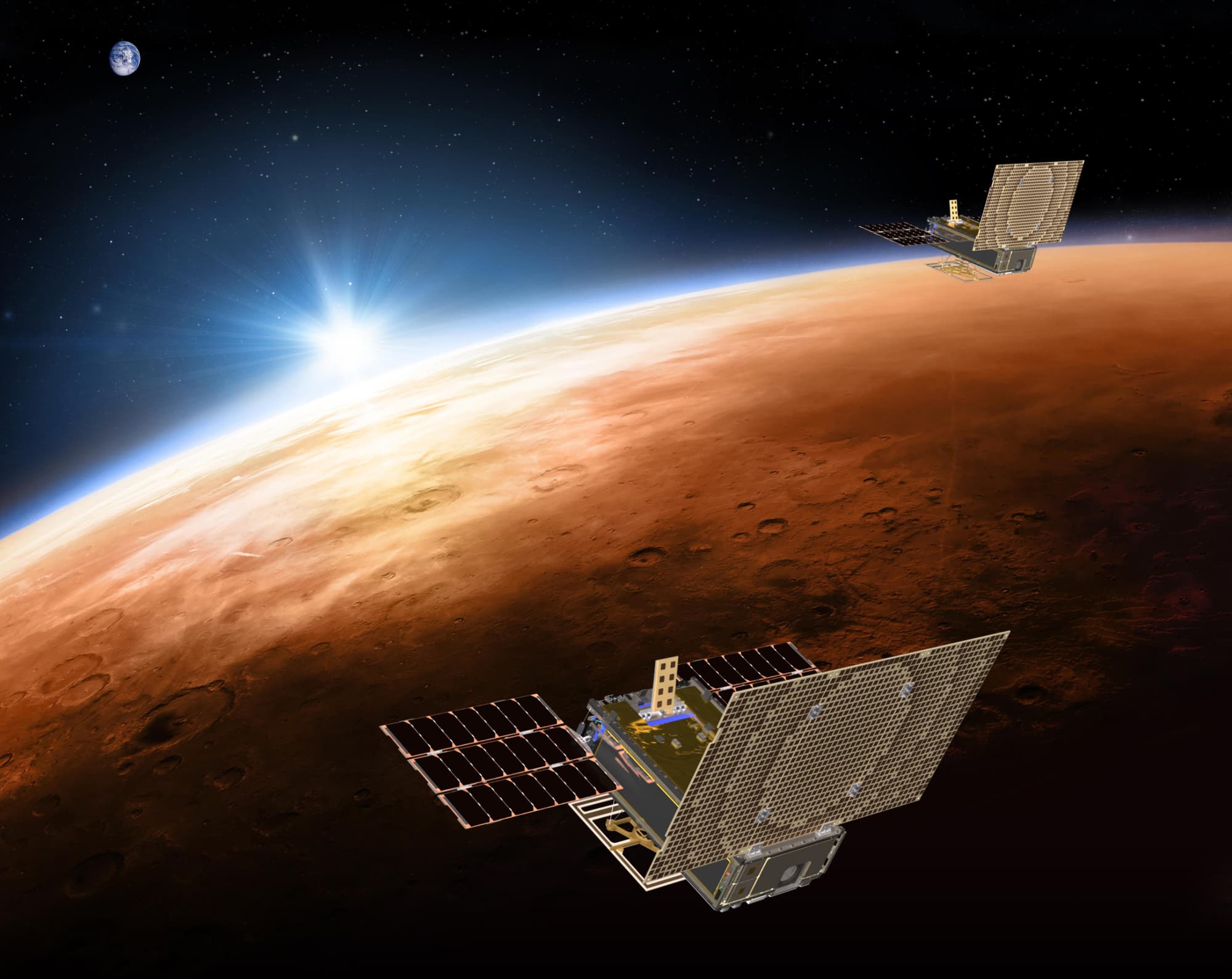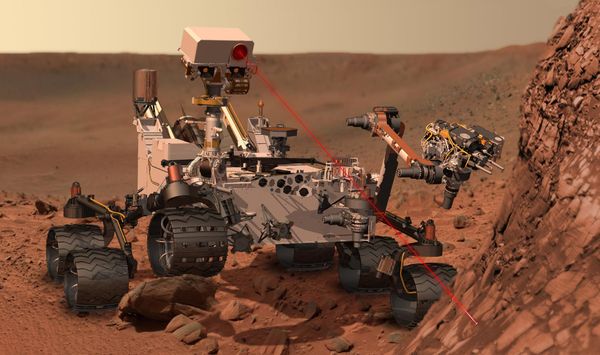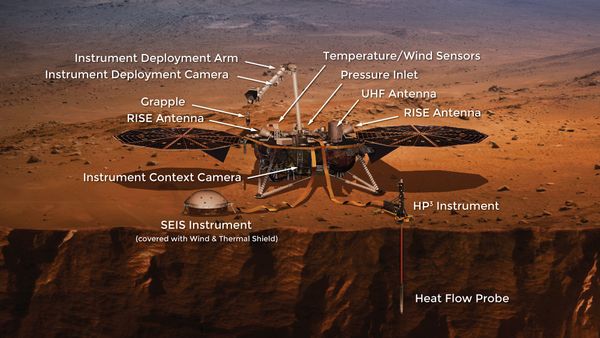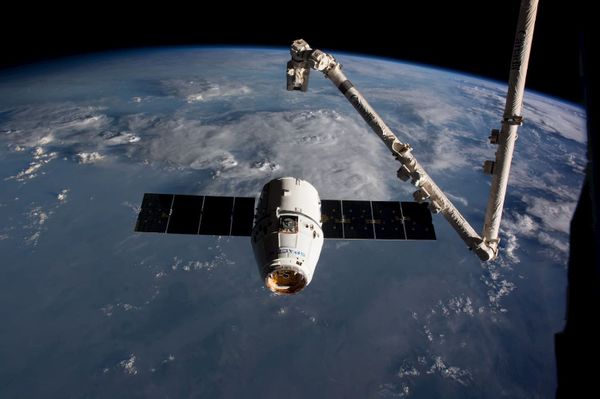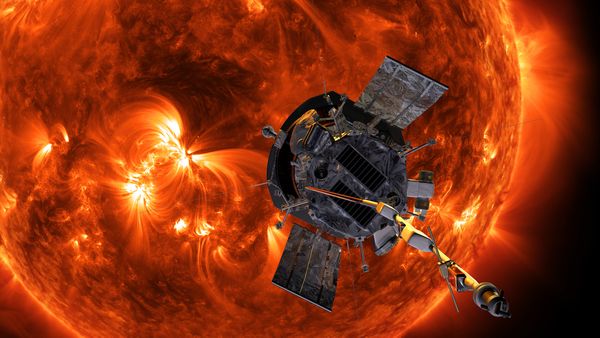Subscribe on iTunes, Google Play, or by RSS for more space exploration discussions. Cover Image: MarCO's Mars flyby, via NASA JPL
This week on SPEXcast we sit down with Jet Propulsion Laboratory (JPL) engineer Joel Steinkraus to discuss two CubeSats hitching a ride with the InSight mission, which launched from Vandenberg Air Force Base on May 5th. Mars Cube One (MarCO) is comprised of a pair of 6U CubeSats which will each relay signals from the InSight lander back to Earth during while it enters the Martian atmosphere. We ask Joel about the technology behind MarCO and the challenges of designing two interplanetary CubeSats.
This is part two of our four part 'Mars May' series where we interview the engineers that make Mars exploration possible. You can check out part one, our interview with Troy Hudson on NASA's InSight mission and check back next week for our coverage of Mars 2020, the follow-up mission to Curiosity that will collect samples for a potential sample return mission.
How a nanosatellite transmits data to Earth from Mars
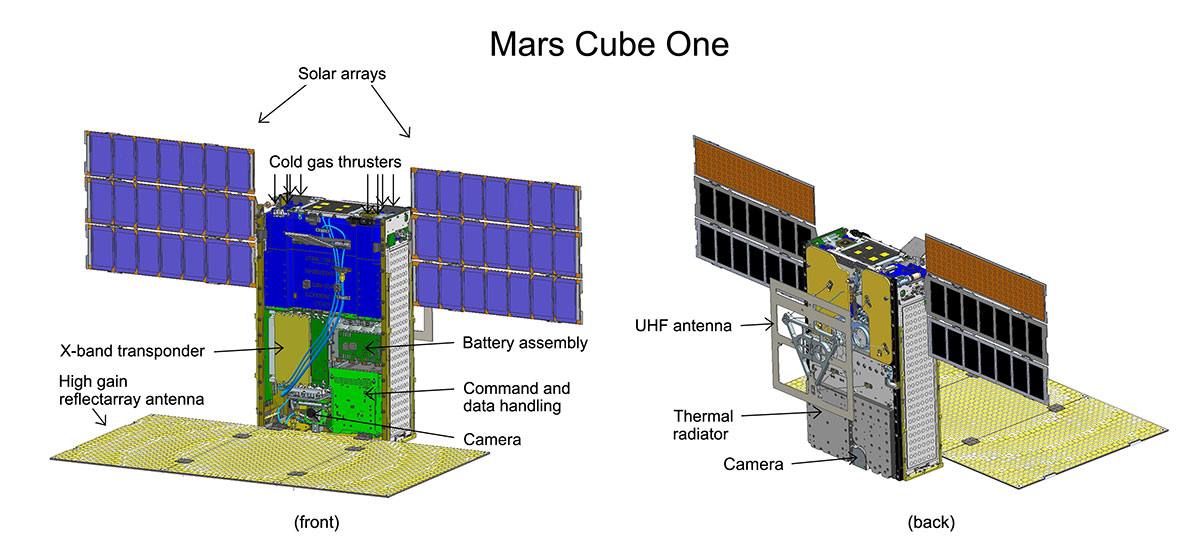
MarCO's entire journey is part of an experiment. Monitoring how systems behave during the interplanetary voyage is valuable because it will aid future nanosatellite technology development for deep space applications. Image credit JPL.
Mars Cube One is is a technology demonstration mission. We don't know what will happen to CubeSats and other nanosatellites in deep space for sure, and one of the best ways to find out is to test it. Both CubeSats in the MarCO mission, MarCO-A and MarCO-B, are identical, and have the same capabilities and objectives. One of the reasons for building them in exactly the same way is in a way a sort of redundancy. CubeSats are too small to have backup systems, and have a high rate of failure relative to larger satellites. Having two systems allows researchers to compare data from two independent sources, which allows them to quantify the variability of the systems' behavior. Plus, if one of the satellites fails outright, they still have another one to continue the journey.
Each MarCO spacecraft is a 6U (30 x 20 x 10 cm) CubeSat with a mass of 13.5 kg. The whole vehicle is essentially a big support system for two primary instruments: a UHF radio receiver (to hear signals from InSight), and an X-band radio transmitter (to talk to Earth). The most prominent feature of the spacecraft is the big X-band reflector array. In this configuration, X-band transponder signals are bounced off the array toward Earth, kind of like a reverse satellite TV dish, to allow downlinks of up to 8 kbps at more than 157 million km away. (It may not seem like much, but remember that this is coming from a cereal box around Mars!) The spacecraft have two deployable solar arrays and a cold gas propulsion system to perform course correction maneuvers (~40 m/s delta-V). Cold gas thrusters will also be used to desaturate attitude control reaction wheels on board.
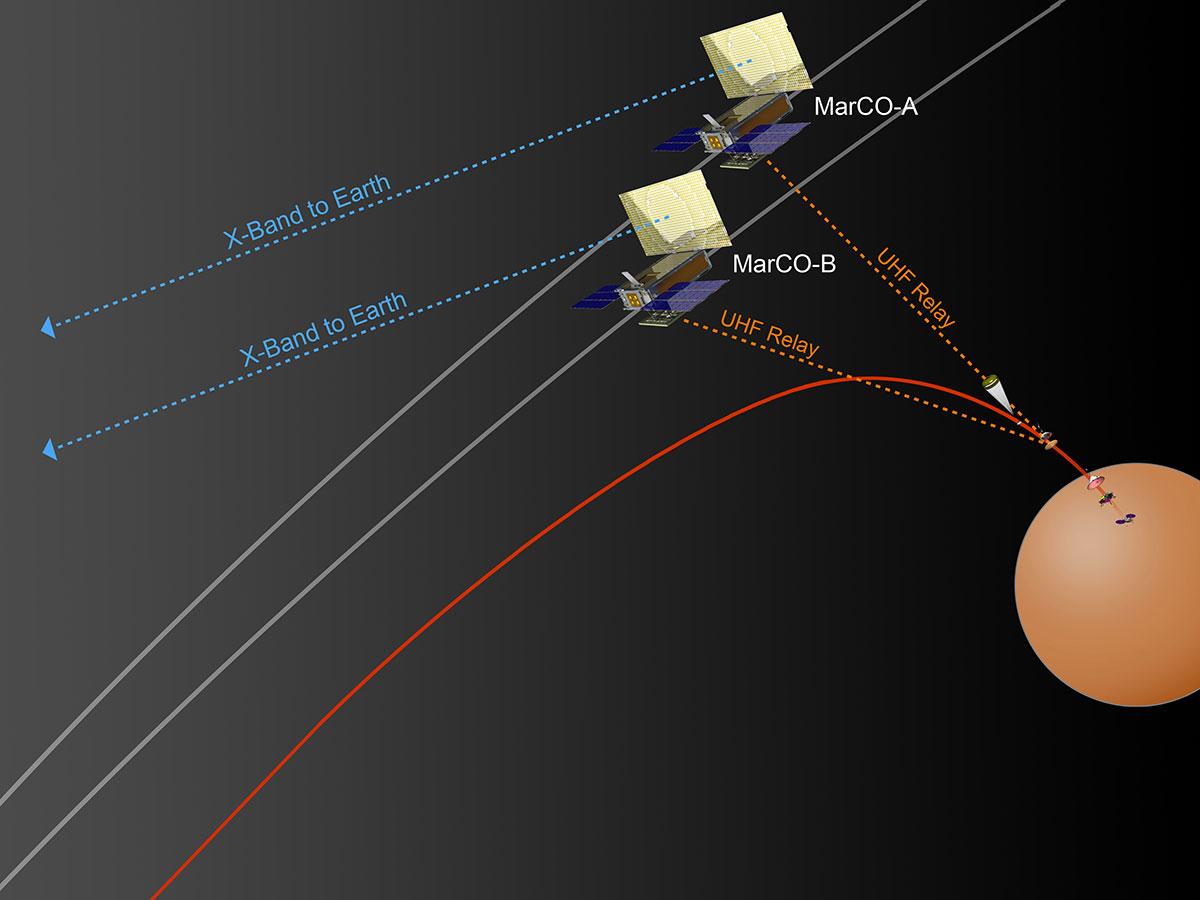
During InSight EDL, each MarCO spacecraft will attempt to receive InSight's 8kbps UHF data stream, package it and send it to the Deep Space Network in near-real-time, since MarCO only adds a small amount of information on top of InSight's messages and the Earth-bound stream is also sent out at 8kbps. "In essence, MarCO is a demonstration of how small spacecraft can work with large spacecraft to provide capabilities that would not necessarily be there otherwise," said Steinkraus. Image credit JPL
The MarCO spacecraft ride out the launch sequence in a CubeSat dispenser mounted to the aft end (near the engine) of the Centaur upper stage. MarCO is protected during launch by the interstage between Atlas V and Centaur. A few minutes InSight separates from the top of the Centaur upper stage, MarCO-A is jettisoned to the side. The stage rolls 180 degrees to jettison MarCO-B a few seconds later. The CubeSats deploy their solar arrays and antennas then coast along to Mars, checking in with Earth and downlinking information about the health of all on-board systems. When InSight begins its entry, descent, and landing (EDL), it will be on the far side of Mars without the ability to contact Earth, so instead InSight will send out data via UHF radio to MarCO and the Mars Reconnaissance Orbiter (MRO), which will relay information back to scientists on the ground. The InSight mission does not depend on MarCO's success. The MarCO spacecraft will continue on into deep space after their close pass with Mars.
MarCO-A and MarCO-B were designed, built, and tested in about 14 months using commercial off-the-shelf parts. This mission is the first step toward the idea that SmallSats and nanosatellites could travel with larger craft in similar support roles on these long interplanetary missions... if they make the trip.
More technical information about the spacecraft specifications and operations is available on the JPL MarCO mission website.
It's about the interplanetary journey, not the destination
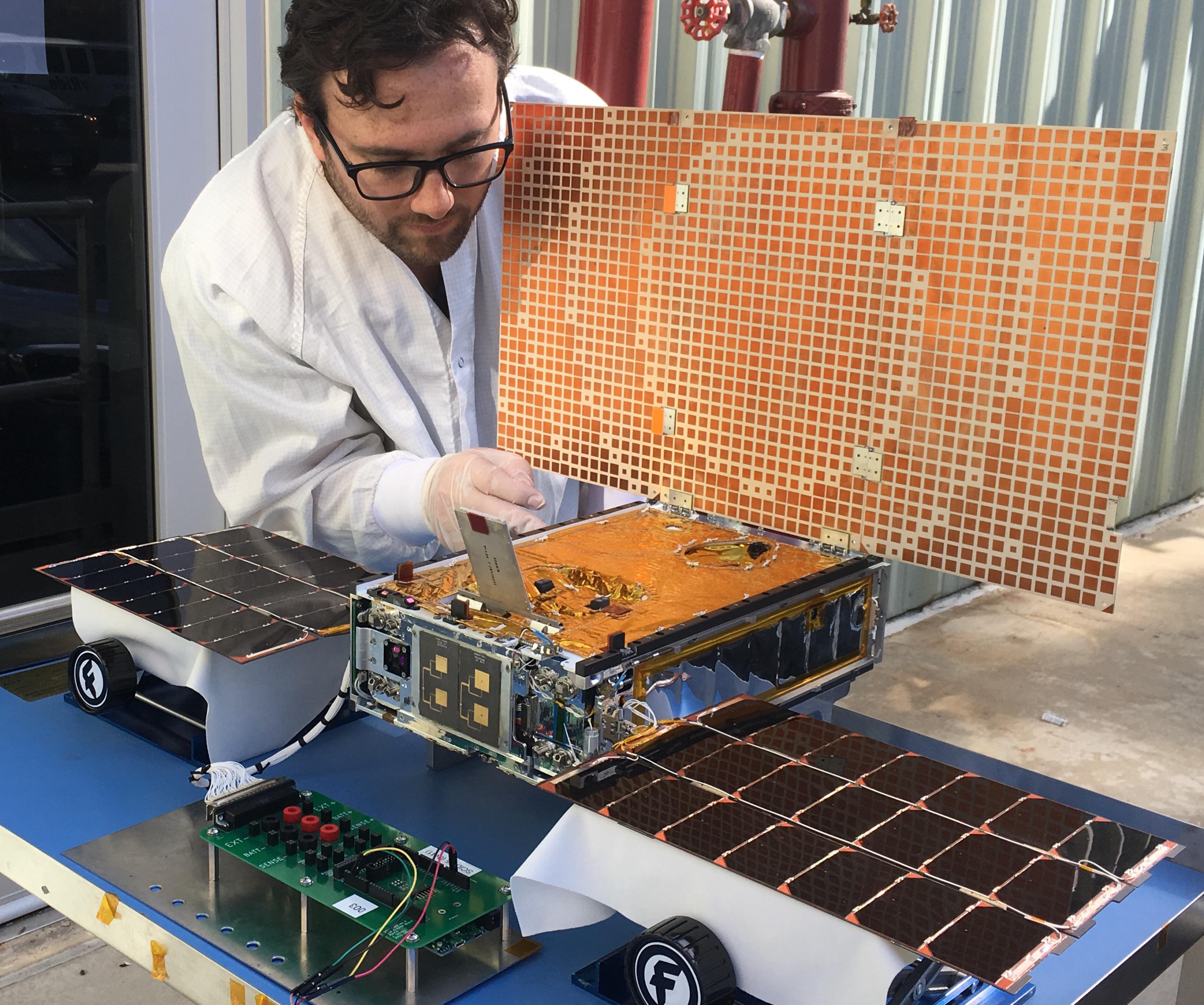
Joel Steinkraus is the lead mechanical engineer for MarCO (that's him in the picture!). One of the major sources of risk for CubeSats comes from deployable systems. If the solar arrays or antennas fail to deploy or encounter an anomaly, the nanosatellite's capabilities could be severely limited... or worse. Image credit JPL.
Author's note: We recorded this episode prior to InSight's launch on May 5th, 2018. The launch was nominal and MarCO spacecraft were successfully deployed.
What is your personal story with the MarCO mission? How did you get involved?
Joel Steinkraus: Before MarCO I had been working at the Jet Propulsion Laboratory for about two and a half years. I had worked on some much larger missions doing electronics packaging, and also on a CubeSat radiometer called RACE that was unfortunately lost with the Orb-3 failure. At the end of that is when I got on the MarCO project. At the beginning of the MarCO project we had a relatively short timespan, about 14 months, to design, build, test, and deliver two CubeSat spacecraft to do what had never been done before--to fly into interplanetary space. The challenge was too much to pass up and I gladly became part of the team, and here we are a little more than 14 months later but we have two spacecraft integrated and ready for launch.
What do you do as lead mechanical engineer?
Steinkraus: One of the largest roles that I had as the mechanical lead was owning the mechanical configuration. One of the awesome things that CubeSats provide to the space industry is their very compact size. However in the design phase this is a really difficult constraint. You have what amounts to a family-size cereal box that you're trying to cram all of the smarts and all of the tools that you need for this Swiss Army knife of a spacecraft to survive in interplanetary space. There's not a lot of room to spare at the end of the day. Also, MarCO had two custom-built deployable antennas.
One of them, our high-gain antenna, which allows us to achieve our 8 kilobit per second data rates at Mars, and that's at the X-band. We also have a deployable UHF antenna. I worked closely with the two engineers that were doing the development of those deployable antennas to make sure that we could actually implement them on the spacecraft--that we could meet their interface needs and that we would ultimately be able to integrate into something that would meet all of our requirements.
And finally I worked closely with all the commercial vendors that provided unique technologies to the MarCO spacecraft to make sure that I could understand everything I could about how their subsystems worked, and how they would integrate with our subsystems so that they would meet all the requirements that we have at the end of the day.
MarCO is the first interplanetary CubeSat mission. Most CubeSat missions are bound to Earth's orbit. What are some of the challenges of adapting the CubeSat architecture to deep space applications?
Steinkraus: Some of the challenges of going to deep space are very similar to the challenges that CubeSats that are in LEO have. Although some of them end up getting harder, a few of them actually get easier. Radiation, for one, is not quite as bad in deep space. That is one benefit we have going for us. As you're in deep space, you don't have to be concerned about about going into eclipse every 60 minutes because there's no planet you're orbiting around. You have a much more open field of view to the universe around you. That's where the simplicities disappear, though.
Where things start getting difficult is that in our case we are always moving further and further away from the Sun, so every day our power is getting less and less. Power is pretty hard to come by in deep space as it is. Also, communicating in deep space is much more difficult than in low Earth orbit. In LEO, you're close enough to Earth that there are enough ground stations and a lot of frequency opportunities to be able to communicate with your satellite. Once you're beyond LEO there's really only one show in town, that's the Deep Space Network. This amazing that is the Deep Space Network has very specific requirements that allow it to do some wonderful things, but also mean that you need a very specialized radio to communicate with it. That radio, called IRIS, was a new technology development for MarCO. Developing that specific radio that would fit in a CubeSat form factor, but allow you to communicate with the the DSN and contain all of the complexities that that involves was an essential technology for MarCO to develop.
Additionally, thermal management is unique in deep space compared to LEO, specifically for CubeSats. It turns out that without any deployables, more traditional CubeSats cover the exterior of their bodies with solar cells. That works out rather nicely in that it keeps those spacecraft somewhere between -30 and +40 C, which is a nice happy place for lots of electronics. Therefore thermal management becomes almost an afterthought on many traditional low Earth orbit CubeSats. Once you get into deep space that paradigm disappears. You need much larger solar arrays in order to get enough power to power all of your subsystems, which means you have much more heat that you can dissipate. On the other hand, you are far away from the warm body that is Earth. So you have one very hot spot on the spacecraft that is the sun, and you have everywhere else which is very cold. MarCO has a very unique set of bespoke thermal blankets that keep it warm when it needs to be cold, but not so warm that we roast ourselves. There was a lot of effort in developing MarCO as a thermally engineered system in order to make sure that this very small box would not get too cold or too hot.
MarCO will be launching along with InSIght. What does the mission profile and mission timeline look like for MarCO?
Steinkraus: MarCOs are currently stowed on the rocket's second stage. About an hour and a half into launch, InSight pops off the second stage of the vehicle. Several minutes after that the MarCOs, one at a time, jack-in-the-box out of their deployment dispensers (that were made by Tyvak) in sort of orthogonal directions away. So you have one MarCO and the other MarCO popping off at about 180 degrees from each other, and InSight going out forward. We've then loosely fly together in a cluster for six months on the way to Mars as three separate entities. And if we survive that whole six months, we reconverge when InSight does its entry, descent and landing. The two MarCOs will fly over and get to demonstrate a "bent pipe" relay. So as InSight is landing, it will transmit in UHF back to the MarCO spacecraft who will receive it, then send it back out in the X-band through our high-gain antenna and transmit that data back with only a small delay and the light-time delay from the signal travelling back to Earth. So the scientists will receive that in pretty close to real time.
So MarCO is acting as a communications relay for InSight. Why can't other Mars orbiters like the Mars Reconnaissance Orbiter (MRO) act as a relay?
Steinkraus: MRO will be receiving and is the primary communications relay for InSight during EDL. However because of the geometry of where MRO is, where Mars is, and where Earth is when they receive this data, they won't immediately be able to transmit it back to Earth. So while MarCO is unnecessary to meet the primary mission goals of InSight, if it is successful it will allow us to get that information back sooner than it would otherwise be able to be retrieved. In essence, MarCO is a demonstration of how small spacecraft can work together with large spacecraft in order to provide capabilities that would not necessarily be there otherwise.
Does MarCO do anything else besides acting as a relay for InSight? Is relaying data the primary goal?
Steinkraus: Actually, MarCO's main goal is not even the EDL relay. The main goal is to demonstrate new technologies on CubeSats in deep space. There are a lot of technologies that had to be developed in order to allow CubeSats to go into deep space, things larger spacecraft have been using forever. I mentioned before that the IRIS radio is a new technology that was developed. Additionally we have deployables for our solar panels, high gain antenna, medium gain antennas and our UHF receiver antenna, whose deployment will be the first test of these in space. We also have the propulsion system which is made by VACCO and an attitude control system (ACS) made by Blue Canyon Technologies, which have flown before but have never been to deep space. Understanding how these systems will behave and ultimately how they will perform is the primary objective of MarCO. Every day we will be getting more and more data which will allow future missions to benefit from the experiences that we've had. If we actually have six months of consecutive days collecting this information, then we'll be able to show off how entry descent and landing goes when InSight lands on Mars.

